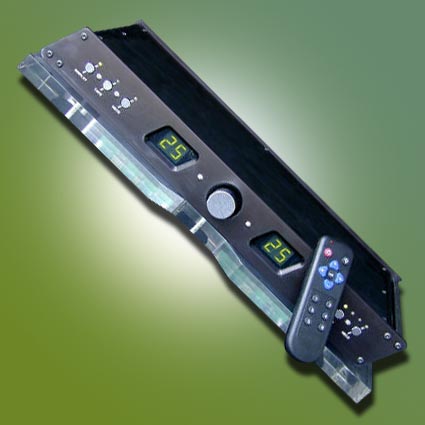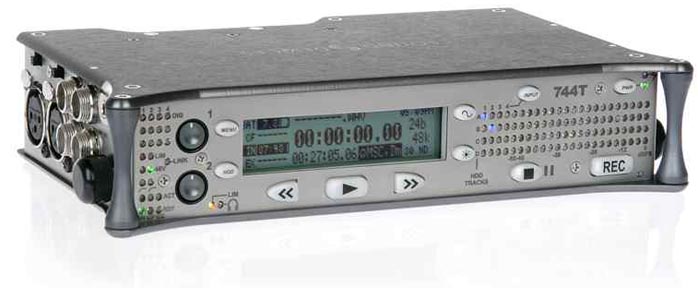|
This review page is supported in part by the sponsor whose ad is displayed above
|
|||||||
 |
|||||||
 |
|||||||
| For 2006 I was privileged to discover two items which enhanced my enjoyment of music and sound reproduction. One will make more sense for most audiophiles, while the other has applications which only a few will find interesting. I submit this short report to cover both bases. During this past spring and early summer I had the opportunity to properly evaluate two Transformer Volume Control line stages which helped to clarify a few sonic issues for me. The primary device was the Opera Consonance Reference 1.3 TVC, which I formally reviewed in August. The history of my experiences with passive line stages is described there and I do owe thanks to my good friend David Vair for first teasing me when he visited about a year ago. He carried along his Bent Audio TX102 TVC, which while an older unit, was outfitted with transformers from Stevens and Billington. In switching from my longtime ARC REF1 tubed line stage to his unit, I was surprised to find attributes which ultimately caused me to explore alternatives in this category of equipment. The Chinese-made Opera unit turned out to be a fine performer, but at the suggestion of Srajan, I was able to briefly borrow a Music First Audio Passive Magnetic Attenuator TVC, which actually did a few subtle things in an even better way. This ultimately inspired me to talk with John Chapman of Bent Audio in British Columbia and I discovered that he was shortly releasing a yet newer iteration of his TVC, employing the latest generation S&B transformers along with various wiring and connectivity options and remote. I decided to go forward with a direct order for one of his TAP Modular Transformer Passive Preamps and sent him my check in order to get in line for one of the early production run units. I did this not as a reviewer but as a consumer, having much faith both in this technology and in John's sincerity, expertise and dedication. Near the end of the summer my TAP arrived, bearing a configuration best for my needs, namely, a six input version with all silver internals. I was thrilled to find that everything which had made such strong positive impressions from earlier trials was now taken to the next level. |
|||||||
| The Bent Audio TAP line stage has been in my system for almost six months and continues to provide highly gratifying amounts of listening pleasure. I spend more time with my system now, and that says a lot, in and of itself. The sound is refined and effortless with dynamics that are seductive. The TAP seems to facilitate a 'see through' quality which we all seek, while avoiding any hint of being over-analytical, etched or sterile. There is a soul to the music I revel in and appreciate. It is more dimensional and transparent, while possessing exquisite tonal balance and a fully non-mechanical sound. Frequency extremes are extended and the involvement factor is captivating. Especially noteworthy with the TAP is the completely noise-free presentation yielding an almost uncanny sense of quiet backgrounds. This is the kind of silence I often associate paradoxically with live music, when the audience is so attentive to the performance that it practically seems to breathe with the performers. [I would be remiss to not give credit to some of the other elements in my system which help to make things so good. The Zu Definition Pro speakers driven by the McCormack DNA500 | |||||||
 |
|||||||
| amp, for the bulk of the frequency spectrum, seem to do their disappearing act even more effectively now and the size of the soundstage has blossomed beautifully, just as an example.] The range of recordings I normally enjoy is widely diverse. Among full orchestral symphonic choices, the Reference Recordings RR-105 CD with Keith Lockhart and the Utah Symphony is a big winner, both musically and sonically, especially the Rachmaninov piece. For jazz material my old time faves from Keith Jarrett take on nuances and shadings which are a treat to witness. I've heard him in solo performance at Lincoln Center as well as in a small bar in the Poconos, where I was literally six feet away from the piano. Through the TAP a sense directness, immediacy and energy rekindles those memories even with things such as his older ECM Köln Concert recording. Rehearing music from Dead Can Dance, Joni Mitchell, Traffic, Vladimir Horowitz or Fritz Reiner transports me to a level of connectedness that has not been this obvious for a long time. Clearly, listening to my own recordings, which are completely unprocessed, has informed me surprisingly well about microphone placement choices as well as the musicians' intentions. That is a major bonus. Let me spare you a long list of specific disc titles and just note that nothing I played has sounded better in my home than it does now. This finely built $2995 package seems to be of exceptional value and all of the operations and functionality are performed flawlessly. I cannot operate without a remote control and that is a major plus with this unit to boot. Srajan has a preview of this TAP where additional technical details are revealed. In addition Kevin Haskin of DIY Cable has recently become the North American source for this unit under the Music First Audio nameplate. The TAP has been a truly rewarding purchase and I encourage anyone who is intrigued by this approach to explore it. Stay tuned for Srajan's upcoming full review. Congratulations John Chapman! |
|||||||
 |
|||||||
My second pick for Best of 2006 is the Sound Devices 744T Hard Disc Recorder. If you have read some of my other reviews, it will be obvious that I enjoy doing live concert recordings of music, primarily in my locale, encompassing mostly classical performances. These are remote captures achieved with a very portable yet serious rig. I became involved in this past-time about seven years ago as a hobbyist and carefully invested in DAT recorders and a few pairs of matched Schoeps microphones. All of that has been much fun and additionally assists in providing insights into the recording process. In mid-2005 I switched from DAT to hard disc recording by purchasing the Sound Devices 744T. This gem of a machine inspires anyone who touches or holds one. It seems to feel like 'Rolex meets Nagra' and that is a very comforting sensation. The best part is that the sound of the 744T is superior to DAT and it all comes in a tiny package, about the size of a pocketbook novel. Interestingly John Marks did a very fine write-up of the SD 722 recorder in the October 2006 issue of Stereophile; it is the junior version of the one I am talking about here. John conveys his excitement over the piece quite nicely and I know that he knows what he is talking about. I've had the pleasure of meeting him a few times at Stereophile Shows, chatting about recording gear etc. and we are both customers and fans of Jerry Bruck, who is one of the fine, highly respected, classical music recording engineers and pro-gear dealers of New York City. Jerry sold the 744T to me just as he was getting enthused about the device himself and it was a fortuitous purchase. While there are several differences between my 744T and the 722 which John describes, the primary one is that the 744T is a four-track digital recorder with time code while the 722 is limited to two tracks. The early time I spent with the 744T in 2005 was very limited and all of that was done in 16-bit/44.1kHz format. Outcomes were enjoyable but personal challenges and difficulties -- which have since diminished -- prevented me from doing a great deal with this device then. This spring I found myself doing a goodly amount of 16/44 concert recordings and these included small madrigal groups, pipe organs, a symphonic orchestra, piano, jazz quintet, choir music and more. A number of those concerts actually are aired locally on our NPR FM station and some of those performances have even reached national distribution with good results. Since early summer 2006, however, I elected to record in 24-bit/96kHz format. Geez Louise! I'm really thrilled with this twist and I see myself doing everything this way from now onward. The sound is marvelous when heard back from the original 24/96 capture directly out of the 744T. Even when converted down to 16/44 CDRs -- which is how the performers and I typically hear the concerts -- I find musical details, spatial cues and lots of other sonic goodies revealed accurately and naturally in a truly effective fashion. In his article, John Marks did suggest that the 722 [which sells for $2,375] might be the ultimate iPod and sonically it would be killer but I think he meant that in jest. My ruggedly-built, compact 744T sells for $3,950 and does include many additional pro features, which justify the cost differential. If any of this piques your interest, visit the company website which provides excellent information about the 744T and other models which are offshoots of this design. |
|||||||
| Clearly the SD 744T is not likely to be part of the equipment line-up for most conventional audiophiles but as a result of this extended experience over a good part of 2006, it has struck a very positive chord with me. Enough so to give credit where credit it due. From a portability, convenience and sonic performance perspective, I am elated with my 744T and look forward to a long and happy relationship with it. [I am happy to report that my entire rig requires only two hands to carry. The electronics and mics fit into a bag just slightly larger than a laptop case, with the mic stand in its own bag; a simple, compact and tidy package.] Incidentally the quality of technical support at Sound Devices, which is based in Reedsburg, Wisconsin, is superb and Justin provides assistance way beyond the call of duty. Congrats to Sound Devices for a terrific product. | |||||||
 |
|||||||
 |
 |
||||||
 |
|||||||